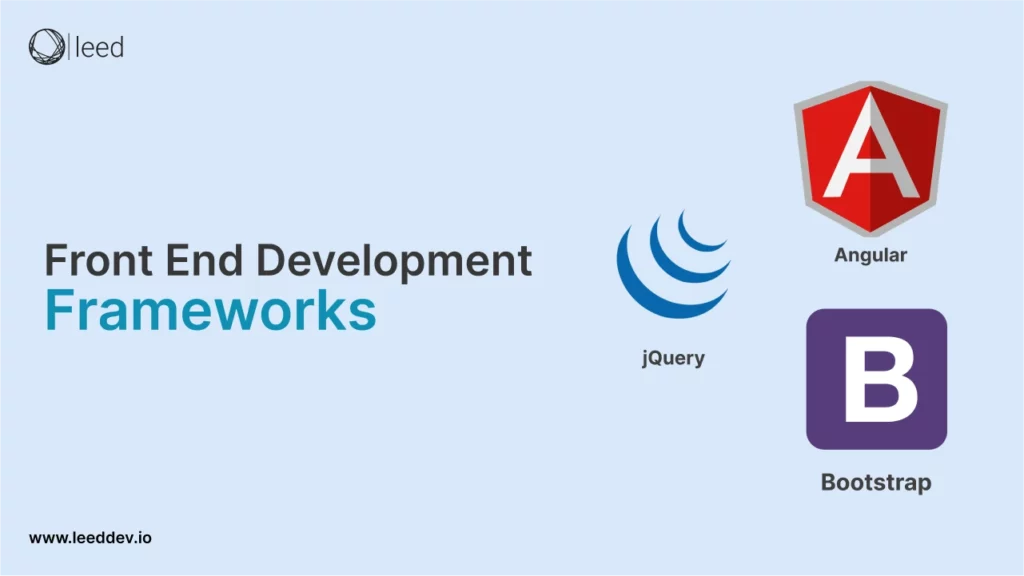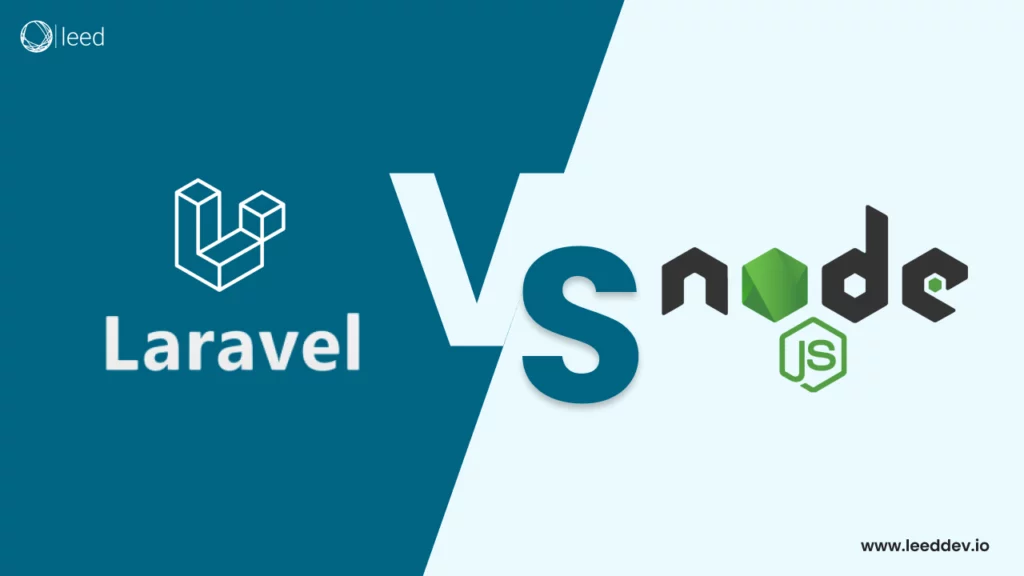In 2025, front end development frameworks play a vital role in building dynamic fast and user friendly web applications. With over 94% of first impressions linked to web design choosing the right front end web development framework is crucial for businesses and developers.
These frameworks offer pre built UI components, structured coding patterns and enhanced efficiency. It reduces development time by up to 50%. Whether you’re a startup or an enterprise selecting from the most popular front end frameworks can help create responsive and scalable applications.
In this guide, we’ll explore a comprehensive front end frameworks list. This will cover both front end technologies and front end libraries like React, Vue, and Angular. Stay ahead in web development by choosing the best framework for your needs.
Best Front End Development Frameworks
Here is the list of best front end development frameworks that are discussed below:
React
React is a JavaScript library created by Facebook in 2013. It helps developers, build fast and interactive user interfaces for websites and web apps. React uses a component-based structure, meaning developers can create reusable pieces of UI, making development quicker and more efficient.
Here’s why you use React:
- Its reusable components save time by using the same UI elements in different parts of the app.
- With Virtual DOM you can update only the necessary parts of the page, making it faster.
- Unidirectional data flow makes the app more stable and easier to manage.
- Large Community & Support as plenty of tutorials, tools, and libraries available.
- Works well for both small and large applications.
Pros & Cons
Pros & cons of frontend development framework React are given below:
Pros:
- Fast Performance
- Easy to Maintain
- SEO-Friendly
- Strong Community
Cons:
- Takes Time to Learn
- Frequent Updates
- Frontend-Only
When to Use React?
When building interactive web apps and single-page applications (SPAs). If you want fast, reusable, and scalable UI components then you can use React as frontend development frameworks. When working on large or complex projects that require efficient updates this is a best option.
When Not to Use React?
If you are new to JavaScript, as learning React might be challenging. For simple static websites, where basic HTML, CSS, or simpler frameworks work fine you should avoid using this. If you need a full-stack solution, since React is only for frontend development.
Angular
Angular is a popular frontend framework developed by Google. It is built using TypeScript and is widely used for creating modern web applications. Angular helps developers build dynamic fast, and scalable single-page applications (SPAs) and progressive web applications (PWAs). It comes with many built-in features that make development easier and more efficient.
The key features of Angular are given below:
- Uses TypeScript, which helps write clean and organized code.
- It has a two-way data binding nature that’s why automatically updates the user interface when data changes.
- With its dependency injection it manages code efficiently, reducing errors and making development smoother.
- Breaks the application into reusable parts, making maintenance easy.
- With its built-in directives it allows customization of HTML elements to improve functionality.
- It has fast performance. Uses Ahead-of-Time (AOT) compilation which makes apps load faster.
- Makes large projects easier to manage by dividing them into small modules.
- Powerful CLI (Command Line Interface) provides tools for quickly setting up and managing projects.
Pros and Cons of Angular
The pros and cons of Angular as a frontend development frameworks are given below:
Pros
- Scalable
- Reusable Code
- Optimized Performance
- Complete Ecosystem
- Google Support
- Strong Community
Cons
- Difficult to Learn
- Heavy Framework
- Complex Code
When Should You Use Angular?
You can use it for large applications like If you are building a big project that needs structure and organization. Great for applications that need frequent updates, like dashboards and chat apps. Many big companies use Angular because of its stability and scalability. You can use it for Progressive Web Apps (PWAs) as it helps build modern, fast-loading web applications.
When Should You Avoid Angular?
If you are making a simple website, Angular may be too complex so it would be better to avoid it. Secondly if your team is new to web development, Angular may take longer to learn. You may need a very fast and simple application so void it and use a smaller framework like Vue or React might be better.
jQuery
jQuery is a fast and simple JavaScript library that makes working with HTML, CSS, and JavaScript easier. It helps in manipulating the DOM, handling events and making Ajax requests while ensuring compatibility across different browsers.
Here’s why you should use jQuery:
- It has cross browser compatibility and works smoothly across all major browsers.
- Simplified DOM manipulation makes handling HTML elements easier.
- Extends functionality with many ready to use plugins.
- Shortens JavaScript code for faster development.
Pros & Cons
The pros & cons of jQuery are given below:
Pros:
- Easy to Learn
- Speeds Up Development
- Lightweight
Cons
- Performance Issues
- Not Modular
- Losing Relevance
When to Use jQuery?
For quick and simple projects that need basic DOM manipulation, you can use jQuery. You can also use it when working on legacy codebases that already use jQuery.
When Not to Use jQuery?
You should not use it for large-scale applications, where modern frameworks offer better performance. If you need high-speed rendering and efficient state management then avoid it.
Vue.js
Vue.js is a lightweight flexible and easy to learn frontend framework designed for building modern web applications. It follows a component based structure and supports two way data binding. This makes it a great choice for interactive UIs.
Here are some reasons that makes it a perfect choice:
- With reactive data binding feature it ensures smooth updates between UI and data.
- Encourages reusable and maintainable code.
- As its lightweight & fast so provides better performance with smaller file sizes.
- Can be added to existing projects easily.
Pros & Cons of Vue.js
The pros & cons of Vue.js are given below:
Pros:
- Easy to Learn
- Fast Performance
- Flexible & Scalable
Cons:
- Smaller Ecosystem
- Scalability Concerns
- Frequent Updates
When to Use Vue?
if you want a simple, fast, and lightweight framework then you can use it. For small to medium sized projects that need flexibility. When you need two way data binding for interactive applications.
When Not to Use Vue?
If you need enterprise-level scalability, React or Angular may be better so try to avoid it. When working with a large team since Vue has a smaller ecosystem compared to React.
Ember.js
Ember.js is a component based JavaScript framework developed in 2011. It features two way data binding similar to Angula. This makes it ideal for building complex web and mobile applications. Companies like LinkedIn and Apple use Ember for its ability to handle large scale applications efficiently.
Here’s why use Ember.js:
- It is fast and well managed as it offers a structured architecture for efficient development.
- Its two way data binding nature ensures seamless synchronization between UI and data.
- Provides built-in solutions for common development needs.
- Older applications remain functional even after updates.
Pros & Cons
Pros & cons of Ember.js are given below:
Pros
- Fast and scalable
- Rich documentation
- Strong routing system
Cons:
- Steep Learning Curve
- Slow Updates
- Not Ideal for Small Projects
When to Use Ember.js?
For large-scale applications that require a structured and scalable frontend it is best. When developing feature-rich web and mobile applications like LinkedIn you can use it. If you need strong routing and efficient data handling its recommended.
When Not to Use Ember.js?
For small projects where the framework’s resources won’t be fully utilized try not to use it. If you have a small development team lacking the expertise to manage its complexity. When you need a lightweight and flexible solution for simple UI development.
Backbone.js
Backbone.js is a lightweight JavaScript framework developed in 2010 by Jeremy Ashkenas. It follows the MVC (Model-View-Controller) architecture. It helps developers build single page applications (SPAs) with a structured approach. It separates application logic from the UI and makes code easier to manage and scale.
Here’s why you use Backbone.js as Frontend development framework:
- It is One of the quickest JavaScript frameworks.
- Its minimalist design provides a simple structure without unnecessary complexity.
- Allows developers to extend functionality using plugins.
- Ensures smooth synchronization between frontend and backend.
Pros & Cons
The pros & cons of Backbone.js are given below:
Pros:
- Lightweight and Fast
- Easy to Learn
- Supports Reusable Code
- Flexible Extensions
Cons:
- No Two-Way Data Binding
- Minimal Features
- Indistinct Architecture
- More Boilerplate Code
When to Use Backbone.js?
When building simple single-page applications (SPAs) like Trello you can use it. If you need fast rendering and efficient updates on the client-side its useable. When working on projects that require frequent synchronization with the server.
When Not to Use Backbone.js?
If you need a full-featured framework with built-in tools (like Angular or Vue) then avoid it. For large-scale applications that demand scalability and advanced UI features. If you prefer less coding effort as Backbone requires writing extra boilerplate code .
Why Choose Leed for Front End Development?
At Leed Software Development we make front end development easy and effective. Whether you need a fast user-friendly website or a modern web app we use the best front end frameworks to deliver high quality results.
How Leed Can Help with Front End Development Frameworks
- Expert in Leading Frameworks
We work with React, Angular, Vue, and more to build smooth interactive and scalable websites. - Fast and Responsive Designs
A slow website can lose 40% of visitors in just 3 seconds. We ensure fast loading, mobile friendly designs to keep users engaged. - Cross-Platform Compatibility
Your website will look great and work perfectly on all devices and browsers. - Easy Integration with Back-End
We connect your front end with APIs, databases and third-party services for a seamless experience. - Optimized for Performance
Our development process focuses on speed security and smooth functionality to improve user experience. - Future-Ready Solutions
With 80% of websites using JavaScript based frameworks we ensure your front end is built with modern long lasting technologies.
Why Leed?
- Experienced Developers
- Customized Solutions
- Reliable Support
- Proven Track Record
Want a modern high performing front end for your website or app? Leed Software Development is here to help!
FAQs
Top Resources for Learning a Front-End Framework in 2025
MDN Web Docs: Offers in-depth documentation for HTML, CSS, and JavaScript.
freeCodeCamp: Free courses on React, Angular, Vue, and more.
Frontend Masters: Paid courses taught by industry experts.
Udemy & Coursera: Affordable courses covering all major frameworks.
YouTube Channels (Traversy Media, The Net Ninja): Free, easy-to-follow tutorials.
Official Documentation: The best source for up-to-date info (React, Angular, Vue, etc.).
GitHub & Stack Overflow: Great for exploring real-world projects and troubleshooting.
What is a Framework in Front-End Development?
A front-end framework is a set of pre-written code, tools, and guidelines that help developers build user interfaces efficiently. It provides structured code, reusable components, and built-in features to speed up web development. Examples include React, Angular, and Vue.
What Are the 3 Types of Frameworks?
Full-Stack Frameworks – Handle both front-end and back-end (e.g., Next.js, Nuxt.js).
Front-End Frameworks – Focus on UI/UX development (e.g., React, Angular, Vue).
CSS Frameworks – Help with styling and layouts (e.g., Bootstrap, Tailwind CSS).
Is React a Framework or a Library?
React is a JavaScript library, not a full framework. It focuses only on building UI components. However, with additional tools like React Router, Redux, and Next.js, it can function as a complete framework.




